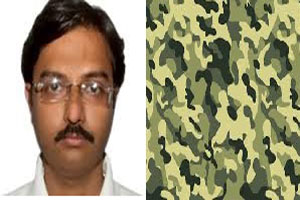
Camouflage developed by Coimbatore scientist a boon for defence ministry
YarnsandFibers News Bureau 2017-03-03 11:00:00 – CoimbatoreA scientist with the Coimbatore-based PSG Institute of Advanced Studies, Amitava Bhattacharya, having pursued his PhD in developing camouflages for defence purposes, has developed two types of camouflage materials that are now under consideration for mass production by the Defence Research and Development Organisation (DRDO). While one can be used for making textiles, the other can be used to cover objects and structures.
Amitaya said that this is called chameleon camouflaging, There are three types of camouflaging - visual, infrared and radar. His work includes all the three areas. The first product that have developed is a textile made of nanocomposite materials. That is a flexible product, that can be bent and folded. It is dyed with a mix of four colours - black, yellow, light and dark green. The dyes are a mix of natural and synthetic materials..
The material for hiding structures and objects is a rigid material. It has coatings on both sides. On the top, it is coated with paints made of nanocomposite materials. These will change colours depending on the temperature.
The other side of the component is made of radar absorbent materials (RAM). These materials have the property of absorbing the infrared radiation and converting it into thermal energy. The minimum requirement set by the defence ministry is 95% absorption, 99% is considered ideal.
The material I developed can absorb IR up to 16GHz frequency. It can be used to cover small buildings, guns, tanks and artilleries. There are many RAM available in the market, but Amitaya have developed his own composition.
PSG is currently funding his research. At present DRDO has given green signal for the work. He is also designing the plan to scale up production.
This technology Camouflage clothing to play a big part in protecting both personnel and equipment from observation by enemy forces as the garment will slowly start changing its colour . The light and dark green will turn into yellow when the temperature crosses 55°C. Once the soldiers return to the plains, the light and dark green colour will return. This will help battalions that have to immediately move to new terrains and will save cost for the defence ministry.
Amitaya said that the technology also has many civilian applications. Think about a tie that changes colour from green to yellow as you step out of the air-conditioned office. Or a sari that shows off a different hue the moment you enter a wedding hall. The possibilities are endless.
Amitava is also a winner of the 3rd National Award for Technology Innovation for the year 2012-13, announced by the ministry of chemicals and fertilizers, under the category of research in the field of polymer science and technology.
Market Intelligence
Ask for free sample Report

experience
Customer Base
dedicated team
Countries Served Worldwide









